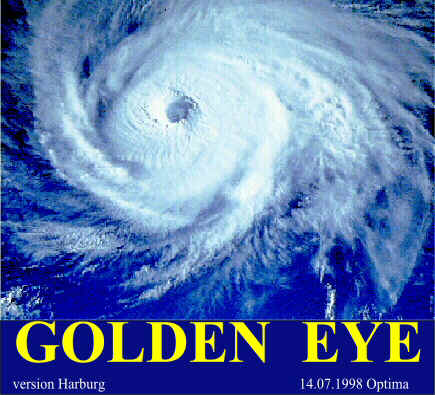|
|
|
| Project duration |
1997-1998
OPTIMA GmbH, AUSTRIA |
| Project tasks |
Golden Eye is created to
recognize oil spots on water surface by monitoring with CCD camera. A
special enlightenment and geometrical location of the CCD camera in a closed
dark box make possible the recognition of objects, floating on water
surface. |
Description |
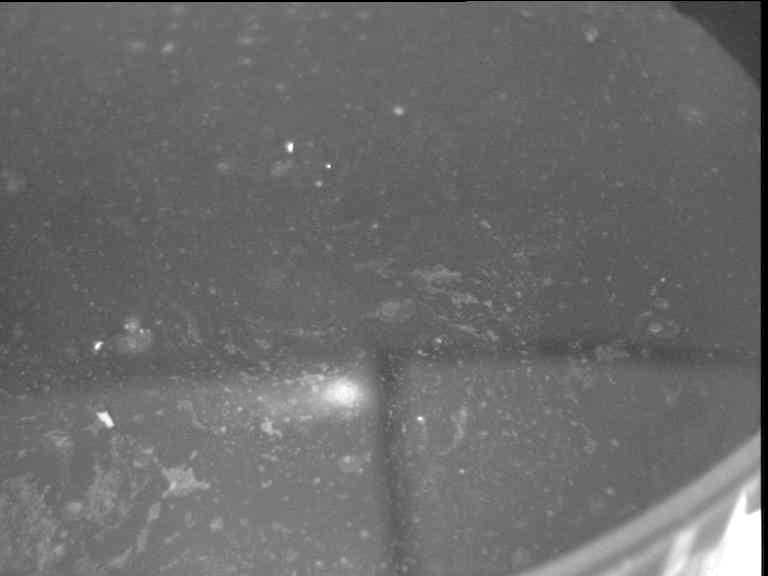
Oil in water
|
The oil spots on water surface are difficult
to be recognized because the oil is spread in a very thin layer and the
colors of water and oil are very similar. Golden Eye uses a perfect method
for enhanced separation of objects using their intensity. The proper
geometrical location of the camera in the black box and the highly sensitive
algorithm facilitate the distinguishing of oil spots from water surface
(background) and visualize them on the computer screen. As a result Golden
Eye shows the surface of oil spots as a percent from the total surface. |
|
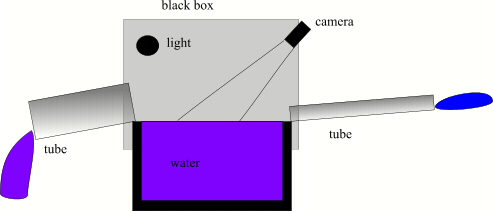
In case of fast running water a potential difference between
the two tubes is necessary.
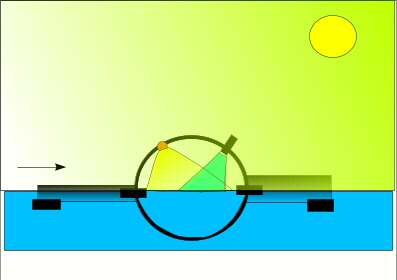
If the water runs not so fast it is possible to use a
floating configuration. The most important thing is to avoid
waves. |
HARDWARE INSTALLATION
The hardware is a system consisting of a black
box, two tubes, a CCD camera and light source. The construction protects the water
surface from the sun light and the use of a special geometrical location for
the light source makes possible the recognition of oil spots. A special
system holds the distance between the water surface and the camera
so that a good picture can be obtained without fixing the focus
every time. It is very important that the water surface is calm at the point
of measuring.
|
SOFTWARE
The programme was created in VisualBasic 6
programming language and uses MATROX graphic card driver system (MATROX
METEOR).This determines some hardware requirements.
To start using Matrox Meteor you need the
following:
Minimum requirements :
- For full Matrox Meteor functionality we recommend
system that uses newer PCI chipsets, such as the Intel 430FX, 430HX, 430VX
(Triton) PCI chipset because they generally offer the required
sustained capability.
- For a Pentium Pro system with a 440FX chipset you must
use a Matrox Meteor /ppb; other versions will not work. In addition, when
using this chipset, the colour grabber might be limited to 5:5:5 (15 bit)
format because of system memory bandwidth limitation.
- For more information please use Matrox Meteor
(Installation and hardware Reference book) 1997.
The programme does not use all the power of the graphic
card. Golden Eye uses only one channel from the graphic card in CCIR
(Initial digitizer configuration format). The so programmed set-up gives
black and white signal in the area of 768x576 points. The Golden Eye
processes in a half of this field.
Golden Eye Menus
Golden Eye is a completed package. It compiles to EXE
code, which uses the MATROX METEOR functions created on C++ and converted to
DLL databases to take the picture from the CCD camera. Golden Eye uses
Windows 95 or Windows NT and is distributed on 3 diskettes (Set-up disks).
One additional disk contains instructions and the necessary information
about the system installation and the system set-up. After set-up
installation you can start Golden Eye from your desktop (the programme menu
on your computer). |
|
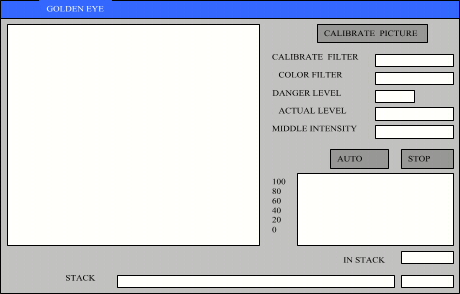
Fig.1General panel
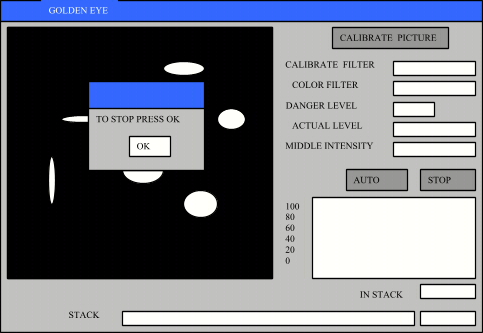
Fig. 2 Hardware calibration
process
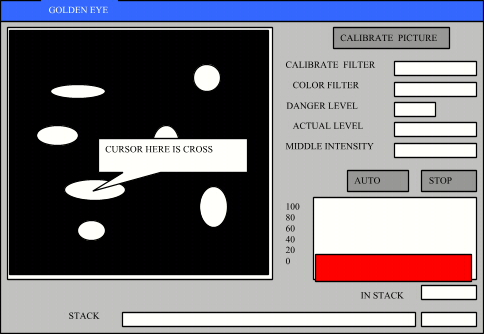
Fig. 3 Obtaining figure for
proper filter
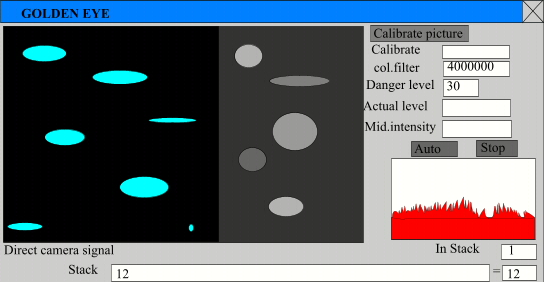
Fig. 4 Example for good
calculation-See Picture Box
|
At starting Golden Eye on your screen for
some seconds an advertisement page appears and the programme displays its
general panel (figure 1) on your screen.
This panel contains Big Picture Box with information from
the camera, three buttons (Calibrate Picture, Auto and Stop), the graphical
box with scale (0-100%) and some other fields which will be described below.
The picture box will be blank. Now you are ready to
start Golden Eye. You can start or stop the data calculation with AUTO and
STOP buttons. You can press STOP button any time when you want to stop and
calibrate the system. Press AUTO to start the Golden Eye. In order to
obtain good results you need to calibrate the color filter. If the color
filter is not correctly set in the COLOUR FILTER BOX, the result will
be wrong.
How to set the filter
color?
Golden Eye has an automated function for obtaining the
light intensity of any point. If you have just started the system, then the
color filter in the box has value 4 000 000. This is the automatically loaded
filter, but probably it is not the proper one for your case. The cursor in
your Picture Box becomes a cross (Fig. 3) and if you click the mouse upon any
point of the Picture Box in the Calibrate Filter field you will obtain the
value (intensity of this point in the range between 0 and 16 777 215, 0 is
black). Press AUTO and then click the mouse on some spot in the Picture Box
screen. So you will obtain the intensity of this point in the CALIBRATE
FILTER box. Now click the mouse on some point of the background and you will
obtain the value for the background intensity. The value that you should
choose for your filter must be between these two values. Write down in the
COLOUR BOX some value in this interval. After some probes you will obtain a
filter value, which is proper for the Golden Eye and the program will
calculate the surface of the spots correctly (Fig. 4).
Protection from false alarm?
The result depends strongly on the picture, taken in an
instant. It is not recommended to draw conclusions based on such
short interval of time. That?s why it is good to make a conclusion based on
the processing of several pictures, taking into account the average value.
This is the only way to protect the programme from producing a false alarm
signal. That?s why Golden Eye saves the data from several pictures in its
memory and the final result is their average. STACK is the
place when Golden Eyes saves the data and the average value will be used for
comparison with the Danger Level. How many values you want to have in
STACK depends on the operator. Golden Eye enables you to keep and compare
data in the range of 1 to 50 units. |
|
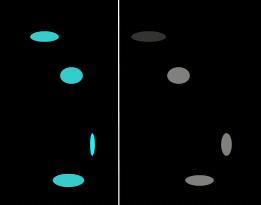
Fig.5 a) and b)
|
Some examples on object processing.
What does exactly appear in the Picture Box
before and after calculation you can see on Fig. 5a and 5b. Picture 5b shows
the intensity of oil spots before calculation. With a naked eye can be seen
three spots. After calculation Golden Eye colors the oil spots in light blue
(Fig.5a) upon black background. How exactly Golden Eye processes the
objects, depends on many factors, as correct filter, proper position of the
camera and light, proper focus, water situation, water velocity, ets).
|
| |
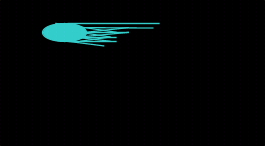
Fig. 6 (Incorrect filter)
|
Figure 6 is an example of a picture, made by
incorrectly set filter. The spot is not well outlined. In this case
a higher value should be given for the filter.
|
| |
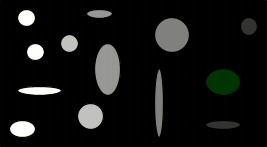
Fig.7
|
In this case ( Fig. 7) the light source is
incorrect and the spots are not equally illuminated. |
| |
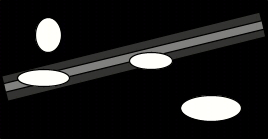
Fig.8
|
On Fig. 8 a uncommon object is visible on
the background (probably some reflection from water surface). In this case
you must be very careful and make Golden Eye calculate this object as
background. This is not a spot and therefore Golden Eye must calculate it
as background (or color it in black) |
| |
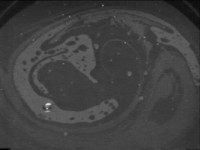
NOT calculated from system real picture
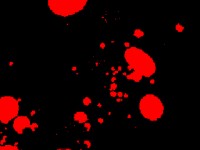
Calculated form system picture ( the spots are in red)

Half of picture is calculated
On the last picture you can see two kinds of oil spots
(calculated in red and green) and water surface in blue |
Some real pictures
|
| |
New interests for oil in water recognition
|
|
| Year 2000 |
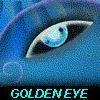 is still interesting for the industry.During 2000 new experiments were
prepared and new set up for testing new software
approaches for oil on water recognition was built. The experiments were carried out in
City University - London UK.
is still interesting for the industry.During 2000 new experiments were
prepared and new set up for testing new software
approaches for oil on water recognition was built. The experiments were carried out in
City University - London UK.
|
Many industrial partners are
involved in this environment protection project. The big challenge in the
future will be tracking, recognition and analyzing oil spots in water with real
time systems. There are many other techniques for oil in water recognition
but image processing is one of the best approaches without moving parts, not
expensive, not high energy consuming and very suitable for automation. This
makes our approach very promising. |
